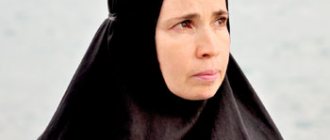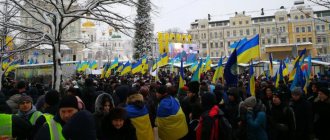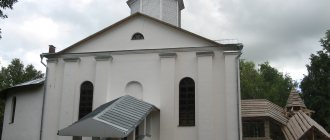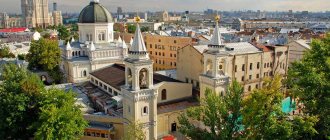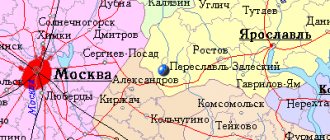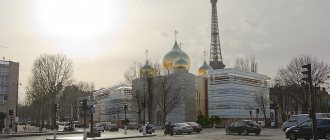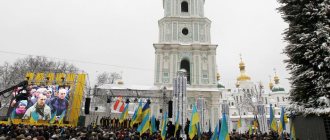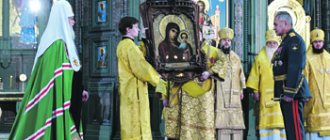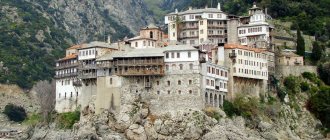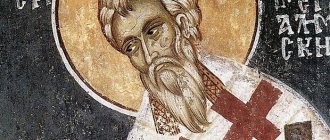| Jerusalem Church of the Resurrection of Christ (Holy Sepulcher) |
Orthodox Church of Jerusalem
(or
Patriarchate of Jerusalem
), an autocephalous local Church
- Official site:
- Canonical territory: Israel, Jordan, Palestine, southern Sinai Peninsula of Egypt
- Liturgical language: Byzantine Greek and Arabic
- Calendar: Julian
- Cathedral: Resurrection (Holy Sepulcher) in Jerusalem (also in Jerusalem there is a patriarchal residence at the Constantine-Eleninsky Monastery in the Old City)
- Primate: Theophilos III, His Beatitude Patriarch of the Holy City of Jerusalem and all Palestine
- Place in diptych: 4
- Composition: 26 bishops; 4 dioceses; more than 50 clergy (ca. 2005) [1]; 50 parishes (ca. 2005) [2]; 25 monasteries (c. 2002) [3]; 1 higher theological school; 400 thousand members (approx. 2005) [2]
Historical sketch
For more information, see History of the Jerusalem Orthodox Church
The history of the Jerusalem Orthodox Church can be divided into four large periods, of which the first is ancient history (-638), the second is the history of the Middle Ages (638-1517), the third is modern history (1517-1856) and the fourth is modern history (1856-1517). to the present day).
The Jerusalem Orthodox Church was founded by our Lord Jesus Christ Himself and can rightfully be considered the Mother of all Christian Churches.
After the ascension of Christ and the descent of the Holy Spirit, the apostles went into the world to preach the Gospel, founding new Christian communities, new Churches. The Jerusalem community was led by Saint James, the brother of the Lord, who is considered its first bishop.
From the first years, the Church of Jerusalem was subject to persecution by the Jews, who gave the Church of Jerusalem the first martyr to suffer for Christ - Archdeacon Stephen. The history of the next two centuries for the Jerusalem Church was not so noticeable.
Through the efforts of Constantine the Great and his holy mother Empress Helena, through the discovery of the Honest and Life-Giving Cross of the Lord and the erection of churches in Holy Places (326), the Church of Jerusalem entered a stage of long-term prosperity until the IV Ecumenical Council (451), at which the title of Bishop of Jerusalem was granted Patriarch. In the next two hundred years, a characteristic feature of the life of the Jerusalem Church was the rapid flourishing of monasticism.
With the conquest of Palestine by the Arabs (638), the life of the Jerusalem Church changes radically: a long period of great tribulation begins. The misfortunes that befell the Jerusalem Church were interrupted for some time by the arrival of the Crusaders (1099), which, however, was followed by the sadder arrival of the Mamluks (XIII century) - the most tragic time in the entire history of the Jerusalem Church. The Mamluks, who hated Christianity, made every possible attempt to destroy everything that had anything to do with Christianity. After the conquest of Palestine by the Turks (1517), a calmer period began in the history of the Jerusalem Church.
From 1517 to the present day, the history of the Jerusalem Church essentially focuses on pilgrimage and the struggle for the Holy Places with the temples built on them. Monasticism is the vigilant guardian of shrines. The claims began back in the 14th century, when the Franciscan monks who arrived in the Holy Land created several communities together with Monophysites of various nationalities and put forward their rights to the Holy Places. Later, all the forces of the West and the East collided here. The Catholic Church could not come to terms with the idea of the Holy Places being transferred to the Orthodox (1634) and did not cease its claims until the 19th century, until this issue was finally resolved by the confirmation of the Status Quo in Paris (1856) and Berlin (1878).
From this moment a new era begins in the history of the Jerusalem Patriarchate. Monks and donors began to buy up land, erecting temples and monasteries on it, rebuilding the ruins and laying the necessary foundation for the normal functioning of the Patriarchate.
Nowadays the monastic clergy consists almost exclusively of Greeks, the white clergy and the laity are overwhelmingly Arabs; recently, many immigrants from the former USSR have also been added.
Literature[ | ]
- Barry, David Sheldon.
The Patriarchate of Jerusalem in the fifth and sixth centuries. — University of Wisconsin, 1976. - Dowling, Theodore Edward.
The Orthodox Greek Patriarchate of Jerusalem. — Society for promoting Christian knowledge, 1913. - Grillmeier, Aloys.
Christ in Christian Tradition: The Churches of Jerusalem and Antioch from 451 to 600 / Aloys Grillmeier, Theresia Hainthaler. - Oxford: Oxford University Press, 2013. - Vol. 2/3. - Hage, Wolfgang.
Das orientalische Christentum. - Stuttgart: Kohlhammer Verlag, 2007. - ISBN 9783170176683. - Peri, Oded.
Under Islam in Jerusalem: The Question of the Holy Sites in Early Ottoman Times. - BRILL, 2001. - ISBN 9004120424. - Speros Vryonis, “The history of the Greek patriarchate of Jerusalem as reflected in Codex Patriarchicus No. 428: 1517–1805", in: Byzantine and modern Greek studies, vol. 7 (1981), London: Basil Blackwell, pp. 29-53.
- A. A. Tkachenko, I. N. Popov, K. A. Panchenko, N. N. Lisova.
Jerusalem Orthodox Church // Orthodox Encyclopedia. - M.: Church-Scientific, 2009. - T. XXI: “Iveron Icon of the Mother of God - Ikimatariy.” — P. 446-500. — 752 p. — 39,000 copies. — ISBN 978-5-89572-038-7. - Panchenko K. A.
On the history of the Jerusalem Church of the 16th century. The failed Arab alternative to the Greek xenocracy or When and where did the Melkite Renaissance begin // Orthodox Palestinian collection. 2011. - No. 107. - P. 271-284
Primates
[4]
- sschmch. ap. James, brother of the Lord (+ c. 63)
- sschmch. ap. Simeon, son of Cleopas (+ 106/107)
- Just (106/108 - 110/113)
- St. Zacchaeus (early 2nd century)
- Tobiah
- Benjamin I
- Joachim I
- John I
- St. Matthias
- Benjamin II, called Philip
- Seneca
- Just II
- Levi
- St. Ephraim I
- Joseph I
- Judas Cyriacus (? - 134/135)
- sschmch. Mark I (134/135 - 156)
- Cassian
- Puvliy
- Maxim I
- Iuliy or Iulian
- Gaius I (c. 160 - 163)
- Symmachus
- Gaius II (c. 165-168)
- Julian or Ualis
- Kapiton
- Maxim II
- Antonin
- Ualis
- Dolikhian (? - 185)
- sschmch. Narcissus (185/197 - approx. 212) [5]
- Diy (211)
- Germanium (211)
- Gordius (211)
- sschmch. Alexander (213 - 251)
- Mazavan (251 - 260)
- Name (260 - 298)
- Zavda (298 - 300)
- Hermon (300 - 312/314)
- St. Macarius I (312/314 - 333/334)
- St. Maxim III (333/334 - 348)
- St. Cyril I (350 - 386)
- St. John II (386 - 417)
- Rule (417 - 422)
- St. Juvenal (c. 422 - c. 458) in 449-451 - Monophysite
- Theodosius, false patriarch-monophysite (452 - 453)
- Gabriel Vrula
(c. 1309)
- Damian (Casatos) (February - July 1897) locum tenens, archbishop. Philadelphian
- Keladion (August 14, 1931 - October 1, 1934) locum tenens, metropolitan. Ptolemaidan
- Meliton (October 1, 1934 - July 22, 1935) locum tenens, metropolitan. Madavonsky
- Athenagoras (Vasiliadis) (1955 - 1957) locum tenens, metropolitan. Sevastian
- German (Mamaladis) (1980 – 1981) locum tenens, metropolitan. Petrsky
- Cornilius (Rodusakis) (December 20, 2000 - August 13, 2001) locum tenens, metropolitan. Petrsky
- Cornelius (Rodusakis) (May 30 - August 22, 2005) locum tenens, metropolitan. Petrsky
Notes[ | ]
- Metropolitan Hilarion (Alfeev), Archpriest Oleg Korytko, Archpriest Valentin Vasechko.
History of religions. - 2021. - P. 244. - Πατριαρχείον Ἱεροσολύμων Archived copy from August 26, 2012 on the Wayback Machine
- The first Arab patriarch on the throne of Antioch.
- Skobey G.N.
Pan-Orthodox Council // Orthodox Encyclopedia. - M.: Church-Scientific, 2005. - T. IX: “Vladimir Icon of the Mother of God - The Second Coming.” - pp. 683-685. — 752 p. — 39,000 copies. — ISBN 5-89572-015-3. - ↑ 1 2
Creeds of Christendom, with a History and Critical notes.
Vol. I. The History of Creeds. — Christian Classics Ethereal Library (unspecified)
(inaccessible link). www.ccel.org. Retrieved March 11, 2016. Archived November 14, 2021. - ↑ 1 2 3 Tkachenko A. A., Popov I. N., Panchenko K. A., Lisovoy N. N.
Jerusalem Orthodox Church // Orthodox Encyclopedia. - M.: Church-Scientific, 2009. - T. XXI: “Iveron Icon of the Mother of God - Ikimatariy.” - pp. 446-500. — 752 p. — 39,000 copies. — ISBN 978-5-89572-038-7. - Patriarchal Epitropies – Patriarchate of Jerusalem – Official website
- Patriarch Irenaeus left the residence / News / Patriarchate.
- Archpriest Vasily Zaev.
Abstract on the history of Local Orthodox Churches.
Patriarchate of Jerusalem (undefined)
. azbuka.ru. - The Jerusalem Patriarchate has created a commission to assist Russian-speaking parishes in Israel. NEWSru.com April 11, 2008
- azbyka.ru current state of the Jerusalem Orthodox Church (undefined)
. - JERUSALEM ORTHODOX CHURCH - Tree (undefined)
. drevo-info.ru. Date accessed: November 9, 2015. - ↑ 12
The consecration of the Church of the Holy Sepulcher Metochion in Nicosia was completed - News - Church-Scientific - “The most important thing is the unity of the Church” // Pravoslavie.Ru
- Opening of the Church of the Exarchate of the Holy Sepulcher in Cyprus.
- website of the courtyard of the Jerusalem Patriarchate in Moscow (unspecified)
. - Archpastoral decree of Metropolitan. New York Philip (Saliba) dated August 7, 2008 (unspecified)
. Archived January 7, 2009.
Saints and shrines
The Jerusalem Church gave the world such saints as Archbishop Cyril of Jerusalem (+ 386) and Patriarch Juvenal of Jerusalem (+ ca. 458); Bishop of Maium Saint Cosmas (+ c. 787), hymnist who compiled canons for many great holidays and Holy Week; venerable founders of the Palestinian monasteries Chariton the Confessor (+ ca. 350) Euthymius the Great (+ 473), Savva the Sanctified (+ 532) and many others.
The greatest shrines of the Jerusalem Church are Calvary and the Holy Sepulcher in the Church of the Resurrection of Christ. The most famous monasteries are the Monastery of the Holy Sepulcher, Bethlehem - above the cave of the Nativity of Christ, John the Baptist - near the Jordan, at the site of the Baptism of the Lord, the Lavra of Saint Sava, in which the relics of the saint are kept.
The current situation of the Jerusalem Orthodox Church
Canonical territory of I. p. c. extends to Israel, the Palestinian Authority, Jordan. Higher governing bodies of the I. p. c. - Local Council and Holy Synod, chaired by Primate I. p. ts. His Beatitude Patriarch of the Holy City of Jerusalem and all Palestine [since 22.8.2005 97th Primate of the I. p. ts. is His Beatitude Patriarch Theophilos III (Yiannopoulos)]. Members of the Holy Synod belong to the exclusivity. the right to elect the head of the Church. Specifics of the procedure for electing the head of the I. p. ts. consists in the recommendatory participation in it of the secular authorities of Israel, Jordan, and the Palestinian Authority, who have the right to provide the patriarchal locum tenens with recommendations on candidates. From among the agreed upon candidates, three are conciliarly elected, from which, in turn, the Primate of the Church is elected by secret ballot by members of the Holy Synod. Since 1534, the Patriarchs of Jerusalem have been exclusively Greek. According to tradition, they make up the overwhelming majority of the episcopate and monastics. The overwhelming majority of white clergy and laity are Arabs. Therefore, the liturgy in monasteries is celebrated in Greek, and in parish churches in Arabic. Residence of the Primate of the I. p. c. located in Jerusalem; The patriarchal church is the Church of the Resurrection of Christ (Church of the Holy Sepulcher). According to tradition, the primate of the I. p. ts. is the head of a special monastic institution - the Holy Sepulcher Brotherhood, the history of which began with the activities of the organizers of Palestinian monasticism, Reverends Hilarion and Chariton the Confessor. In the beginning. 21st century The Holy Sepulcher Brotherhood (with its residence in the monastery of Saints Equal-to-the-Apostles Constantine and Helen in Jerusalem) unites under the leadership of the primate the entire fullness of the priesthood of the I. p. Its main tasks - protecting the purity of Palestinian Orthodoxy, caring for the Holy Places of Palestine, leading groups of pilgrims during their stay in the Holy Land.
I. p. c. includes the following dioceses: Ptolemaid Metropolis (see in Akka), Nazareth Metropolis (see in Nazareth), Patriarchal Epitropy in Amman (Jordan), Patriarchal Epitropy in Irbid (Jordan). Autonomous part of the I. p. c. is the Sinai Archdiocese with the monastery of the Holy Martyr. Catherine on Mount Catherine (the primate bears the title of His Eminence Archbishop of Sinai, Faran and Raifa, with residence in Cairo). The largest spiritual and administrative centers of the I. p. c. are: Caesarea, Diokesarea, Petra, Scythopolis, Naples, Vostra, Elevferupol, Tiberias, Kyriakupol, etc. In the 20th century. a number of parishes of the I. p. c. were formed. in America. Episcopate I. p. c. has 20 bishops. It has jurisdiction over 37 parishes in Jordan, 17 in Israel and 11 in Palestine. Of the 24 monasteries in the jurisdiction of I. p. c. 19 are located in the Old City of Jerusalem. The most famous monasteries are: the monastery of the Holy Sepulcher, Bethlehem (above the cave of the Nativity), St. John the Baptist (near the Jordan River, at the site of the Baptism of the Lord), Lavra of St. Sava the Consecrated (with the relics of the saint residing in it). Number of flocks I. p. c. is approx. 250 thousand people (2005).
There are Orthodox schools, gymnasiums, and lyceums in Jordan and Israel; in Akkaba - Patriarchal School. Publishing house I.p.ts. - the oldest in Palestine (founded in 1853). The following magazines are published: “New Zion”, “Voice of the Lord”, “Voice of Jerusalem”.
From history we learn that Jerusalem was founded by the high priest Melchizedek
The history of this holy place is very rich. According to legend, the city of Jerusalem was founded by the high priest and king Melchizedek, who brought here the body of the first man, the forefather Adam, and buried him on Mount Golgotha.
Meeting of the High Priest of Jerusalem Melchizedek and Abraham. It was he who buried Abraham on Mount Golgotha
In 1004 BC, King David made Jerusalem the center of the Israeli state. At the end of the 11th - beginning of the 10th centuries, the city was fully formed and became the greatest architectural structure of that time.
7 wonders
Solomon's Temple is one of the wonders of the world
This is confirmed by at least the mention of the beauty and splendor of the Jerusalem Temple built by Solomon, which was rightfully considered his greatest work.
Solomon's Temple was called in ancient times one of the 7 wonders of the world. It amazed eyewitnesses with its grandeur and enormous size.
This is what the first temple or Solomon's temple looked like in Jerusalem
